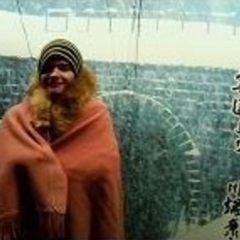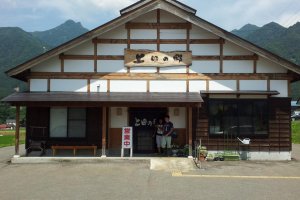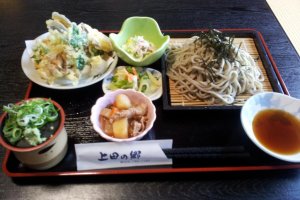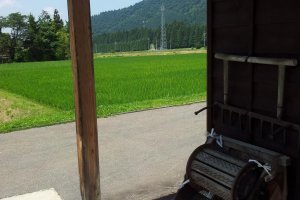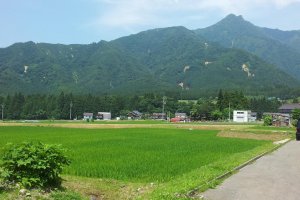Ueda no Sato is a great local restaurant offering countryside staples as well as the chance to go hands-on with some traditional techniques.
We went there for lunch after a recommendation from a friend and knew we were in for a good thing when we saw the place filled with local workmen. Out in inaka (the countryside) there is no shortage of restaurants offering soba noodles, koshihikari rice and fresh seasonal ingredients, but Ueda no Sato really stands out. It is right in the heart of rice-growing country and surrounded by mountains and market gardens. The daughter of the owner has spent time abroad and was able to guide us through the menu, explaining that almost everything in the meal is handmade on site from ingredients sourced locally from other members of the community. Everything about this restaurant is closely connected to its location.
We opted for one of the recommended menus which was the tempura and soba set. The noodles were handmade and the crispy battered vegetables were stunning. Fresh, seasonal and reasonable, this place ticked all the boxes. We’ll definitely be going back. It was a hard choice between noodles and the rice. The rice in this area is supposedly some of the best in Japan, and at Ueda no Sato they get it from their own rice fields and cook it in the traditional way in a metal pot over flames. This is supposed to produce the best possible flavour and I must admit to being intrigued. I’ll definitely be putting this boast to the test in the future.
It turns out that Ueda no Sato is much more than just a restaurant. It has been in the family for generations with several members working there daily. They draw on their rich knowledge of the region and traditions to offer courses to visitors so they can get to know more about the local area and people. The family offer a variety of “Countryside Experience” courses. Their most popular course is making soba noodles and you can see the rolling pins, giant knives and chopping boards on display. You can also try your hand at several different kinds of traditional treats, most of which (unsurprisingly for such a remote area) seem to involve rice in one form or another. More unusually they have some seasonal courses that let you get a glimpse of what life in this area would have involved; planting rice by hand, harvesting vegetables, making sauces from scratch, harvesting rice, weaving straw sandals or building traditional Japanese snow shelters. Most of these have delicious food waiting for you at the end of your labour.
It is a true taste of the countryside served up in a beautiful location.

